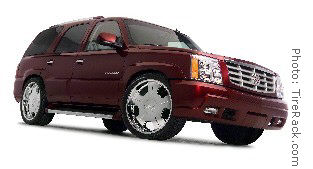NEW YORK (CNN/Money) -
One of the easiest ways to add a dose of individuality to a car is with a new set of wheels. Extra large wheels, especially on SUVs, are particularly popular.

Large wheels can provide benefits in handling and performance. They can also make a car stand out in a crowd. But they can also be dangerous.
Drivers who swap out their wheels for something bigger, even if they compensate for the added size by switching to narrower, low-profile tires, may be putting themselves at greater risk of a crash. If the overall diameter of the tire and wheel combination is larger, that just creates additional problems.
Putting larger wheels on a vehicle than the ones with which it left the factory can cause problems for a vehicle's suspension and brakes even if lower-profile tires keep the overall diameter the same.
The reason is, simply, that metal weighs a lot more than rubber and air. A vehicle's suspension and braking systems are engineered to deal with a certain amount of "unsprung weight."
Unsprung weight is the weight of a vehicle that is not held up by the springs that support the vehicle at each of its wheels. Unsprung weight includes the axles, wheels and tires. Bolting on larger metal wheels gives your vehicle's springs and shock absorbers more weight to contend with.
"If you're going to increase the weight of the wheel and tire you may want to look at upgrading the suspension to handle that extra weight," said John Rastetter, director of tire information services for TireRack.com, a tire and wheel retailing Web site.
The additional weight of the wheels also makes the vehicle take longer to stop, said Andrew Markel, editor of the trade journal Brake and Front End magazine.
Taking rubber away
The thinner tire walls won't absorb as much of the impact as the old, fatter tires did, either. That increases the impact from bumps that the vehicle's suspension system needs to deal with.
Thinner tires are especially problematic for bigger, heavier SUVs. When a vehicle hits a rock or the side of a pothole, the tire flexes under the weight of the impact. With a thin sidewall and a very heavy vehicle, the tires can actually get pinched under the wheel rim, damaging the tire and perhaps leading to a blowout.
Bigger all around
If the overall size of the wheel and tire combination is increased, the tire tread and sides can rub or bump parts of the car including suspension components or fenders.
Tire "fitment," as it's called, is rather tricky. The wheel might work just fine when the vehicle is stopped or even when it's driving and turning on a smooth, level road with a light load. When the vehicle is loaded with people or baggage, however, the tires can bump into parts of the car.
Not only can that damage the tires, it can also cause unpredictable steering difficulty. Plus, it's just plain irritating.
Does not compute
Increasing your car's overall wheel size can also mislead your car's computerized systems about how fast the vehicle is actually going.
Your car's speedometer calculates how fast the vehicle is moving based on how fast the wheels are rotating. But larger wheels rotating at the same speed as smaller ones will make the vehicle go faster. So switching to larger wheels without adjusting the speedometer to compensate can cause you to be going faster than the speedometer indicates.
That can create problems for systems like the car's anti-lock brakes and stability control programs, besides just leading to more speeding tickets.
Staying safe
The key to getting a new set of wheels is getting the right advice.
"What we suggest to consumers is to go to a reputable wheel and tire dealer," said Peter MacGillivray, vice president for marketing and communication for the Specialty Equipment Manufacture Association.
A reputable shop shouldn't allow you to walk in and just tell them what you want. "No offense, but we don't trust you," said Rastetter of TireRack.com.
The TireRack.com Web site requires shoppers to input the specifics of their car and will only allow shoppers to buy tire and wheel combinations that are appropriate for that vehicle. A good tire and wheel shop, experts say, should do the same.
TireRack.com also does not sell "spinners," or wheels that have a freely rotating decorative hub to give the illusion the wheel is spinning when it's not. Those decorative additions add substantial weight with no benefit, Rastetter said. Also, if moving parts begin to corrode, the spinning section could break off or freeze in place, which would make the wheel unbalanced.
Cheap knock-offs
With the expanding popularity of decorative wheels, a lot of new companies are entering the market -- and not all of them are producing top-quality products.
There is no regulatory agency or organization responsible for making sure that wheels that are sold in the U.S. are strong enough or, for that matter, even perfectly round.
"What we're seeing is Chinese knock-offs where the castings are pretty bad and the wheels are pretty fragile," said Markel.
Not all wheels made in China are of poor quality, Markel added, since reputable companies have manufacturing plants there. But buyers should beware of cheap wheels that won't stand up.
Buyers should, ideally, looked for forged rather than cast wheels.
Forged wheels are stronger, which makes them more expensive, but lighter. The price of wheels generally varies inversely with their weight, Rastetter said. Inch-for-inch, cheaper wheels are usually heavier, too.
As always, watch for prices that look too good to be true. For example, if you see 18-inch rims selling for $80, you should be suspicious, Markel said.

|

